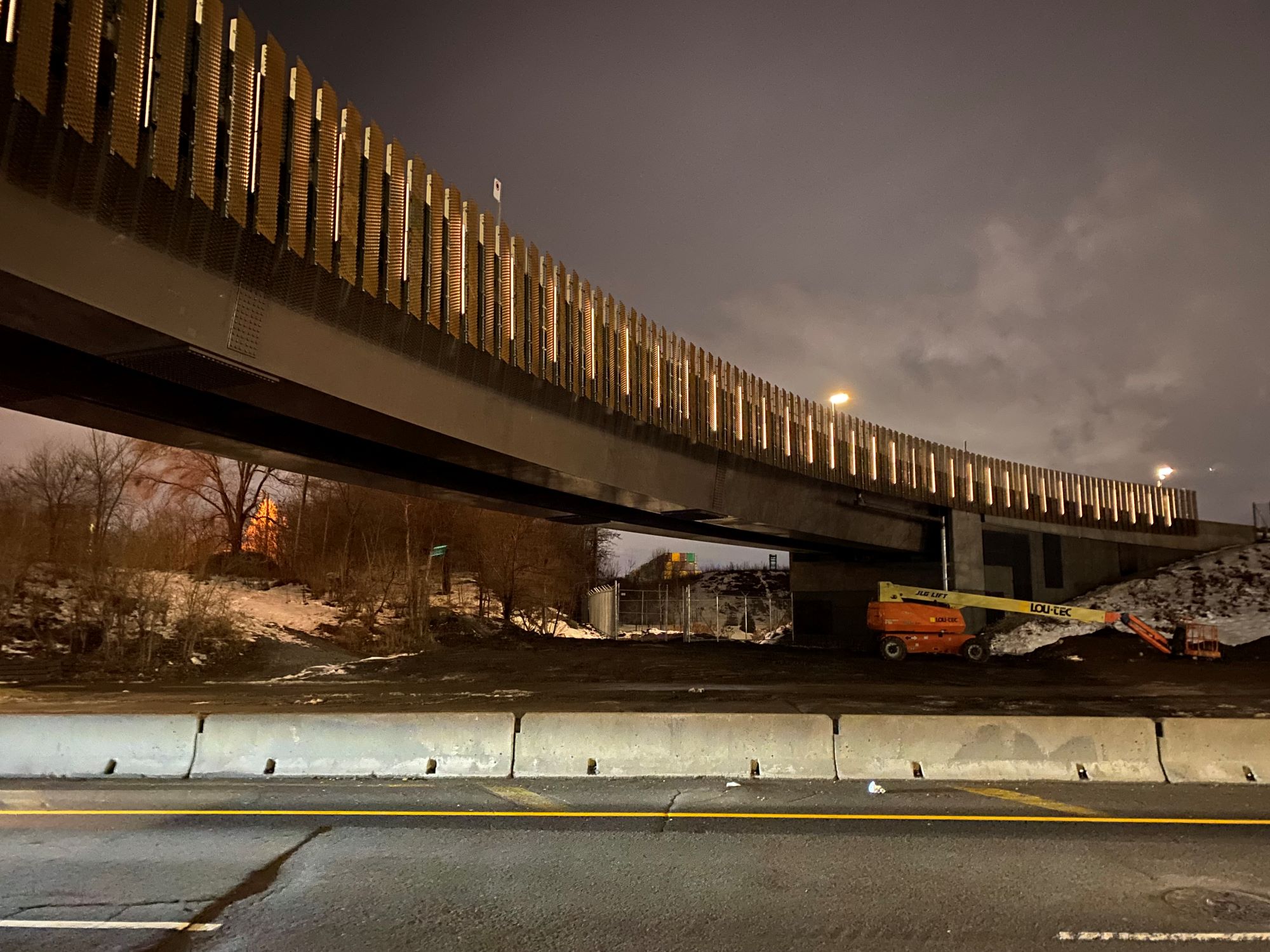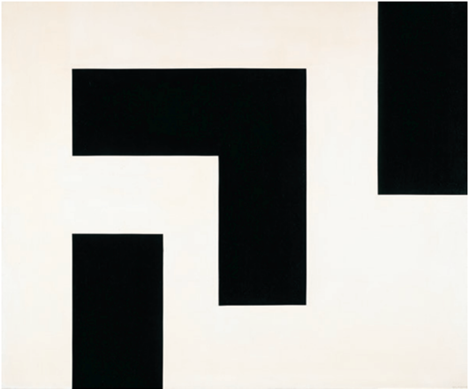
Work honouring artist Guido Molinari integrated into design of Port of Montreal overpass
Press release
Montreal, December 13, 2023 – After two and a half years of construction, the Port of Montreal has added a final touch to its overpass in the Viau sector, named the Vickers Overpass in honour of an important part of Montreal's port history. This new infrastructure incorporates many sustainable components into its design and construction, as well as a sleek design that includes an artistic concept inspired by the work of artist Guido Molinari (1933-2004). The project pays tribute to an artist who set up his studio and worked in the Mercier–Hochelaga-Maisonneuve district, and also promotes the harmonious integration of port facilities into the urban fabric.
The overpass is designed to improve freight traffic flow and reduce truck traffic on the local road network.


The artistic component
With an eye to visual integration into the urban landscape, the concrete walls of the Vickers Overpass are enhanced by an artistic component referencing Guido Molinari's visual signature. Achieved in collaboration with the Guido Molinari Foundation, this artistic integration project pays tribute to the artist, who established his studio in the Mercier–Hochelaga-Maisonneuve district, at the corner of Darling and Sainte-Catherine streets, and was the driving force behind the Foundation’s creation.
Sustainable and visual features in the bridge’s construction
In compliance with the recommendations issued by the Office de consultation publique de Montréal and the wishes expressed at a meeting with residents in 2019, several visual and environmental elements were included in the project's design, in addition to the artistic component:
- Landscaping featuring furniture, a bike stop with bike racks, a bike repair station and site lighting
- Around 400 trees planted near the structure and in Viauville
- Rainwater management using drainage channels to capture surface water and let it seep into the water table
- Use of recycled glass in certain concrete components
- Architectural sails in atmospheric steel, a recyclable metal that improves with wear and oxidizes, evoking the sector's industrial past
- Lighting that creates an effect in the sky canopy in compliance with International to Dark-Sky Association standards
Why the Vickers Overpass?
The Port of Montreal overpass is named after an organization that is part of the city's rich port history: the Vickers shipyard, which opened in 1912 and operated until 1988. Dedicated to shipbuilding and repair, Canadian Vickers was then located in the town of Maisonneuve (along Notre-Dame Street near Viau Street). Canadian Vickers was instrumental in the manufacture of submarines, warships, winches, boilers, ships and trawlers during both world wars, as well as the construction of 369 metro cars for the City of Montreal.
Valuable assistance
Begun in June 2021, construction of the overpass represents a total investment of $47.8 million. To complete the project, the Montreal port Authority (MPA) received $6.7 million in financial support from the provincial government under the Avantage Saint-Laurent initiative for the construction and repair of maritime infrastructure. The MPA also received $7.7 million in financial support from the federal government under the National Infrastructure component of the New Building Canada Fund.
For more details on the project’s timeline, please visit our web page
Quotations
"The Port of Montreal is proud to deliver a new infrastructure that combines the performance objectives of port operations and the reduction of truck traffic on the local road network with seamless integration into the urban landscape. This project attests to our concern to harmoniously cohabit with the neighborhood, and is in line with our long term vision of being a pillar of the city's development from a sustainable perspective," said Geneviève Deschamps, Interim President and Chief Executive Officer of the MPA.
“The Port of Montreal is an economic driver for the city and Quebec as a whole. It's also an institution that's firmly rooted in its community as illustrated by the inclusion of the work of a renowned local artist like Guido Molinari. By investing to support the construction of the overpass, we are strengthening our supply chains, stimulating our economy, and helping the Port play a greater role in the well-being of the people of Hochelaga-Maisonneuve,” said the Honourable Pablo Rodriguez, Minister of Transport and Quebec Lieutenant.
"The architects and designers associated with this project went through every detail of Guido Molinari's work that might lend itself to such a structure. In the spirit of the artwork, and guided by the studies of art historian François-Marc Gagnon, they chose this motif, taken from the Black Angle painting, as the source for this version. We're delighted that the community has recognized through this gesture the great influence that this artist's work continues to exert to this day, and the legacy of a Foundation dedicated to the promotion of the arts and ideas," said Francine Savard, artist and graphic designer.
Operated by the Montreal Port Authority (MPA), the Port of Montreal is the second largest port in Canada and a diversified transshipment centre that handles all types of goods: containerized and non-containerized cargo, liquid bulk and dry bulk. The only container port in Quebec, it is a destination port served by the largest shipping lines in the world. It is also an intermodal hub with a service offering that is unique in North America, featuring its own rail network directly dockside connected to Canada’s two national rail networks. The MPA also operates a Cruise Terminal and a Port Centre. The MPA factors economic, social and environmental components into its corporate initiatives. This commitment is governed by a sustainable development policy whose guiding principles focus on involvement, cooperation and accountability. Port activity supports 19,000 jobs and generates $2.6 billion in economic benefits annually. Inaugurated in 2011, the Guido Molinari Foundation is an exhibition, documentation, conference, education and creation center whose mandate is to maintain a reference museum for Molinari's work and to promote the presentation of other contemporary and current artists. The Foundation welcomes artists in residence who wish to develop historically aware projects. To further develop its vocation for the benefit of all citizens, access to all its activities is free of charge. About the Port of Montreal
About the Guido Molinari Foundation
— 30 —

